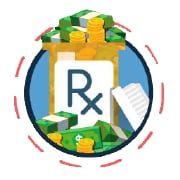Heart Disease and Stroke


High Blood Pressure and High Cholesterol
Smoking and secondhand smoke exposure, obesity, unhealthy diet, and physical inactivity.
More than 877,500 Americans die of heart disease, stroke, or other cardiovascular diseases every year. Heart disease and stroke are the first and fifth leading causes of death in the United States.
CDC supports programs that help millions of Americans control their high blood pressure, prevent risk factors for heart disease and stroke, and reduce health disparities, which are differences in health across different geographic, racial, ethnic, and socioeconomic groups. These efforts have helped lower death rates from heart disease and stroke.
In the United States, cardiovascular diseases cause:

1 IN 3 DEATHS
or more than 859,000 people each year.

$216 BILLION
in health care system costs.

$147 BILLION
in lost productivity on the job from premature death.
The Nation’s Risk Factors and CDC’s Response
Leading risk factors for heart disease and stroke are high blood pressure, high low-density lipoprotein (LDL) cholesterol, diabetes, smoking and secondhand smoke exposure, obesity, unhealthy diet, and physical inactivity.

High blood pressure is a leading cause of heart disease and stroke because it damages the lining of the arteries, making them more susceptible to the buildup of plaque, which narrows the arteries leading to the heart and brain. About 116 million US adults (nearly 1 in 2) have high blood pressure, defined as 130/80 mm Hg or higher. Only about 1 in 4 of these people have their high blood pressure under control. About 7 in 10 people who have a first heart attack and 8 in 10 people who have a first stroke have high blood pressure.
Eating too much sodium can lead to high blood pressure. Americans aged 2 years or older consume an average of about 3,400 mg of sodium each day, well over the 2,300 mg recommended by the Dietary Guidelines for Americans . More than 70% of the sodium Americans consume is added outside the home (before purchase), not added as salt at the table or during home cooking.
High LDL cholesterol can double a person’s risk of heart disease. That’s because excess cholesterol can build up in the walls of arteries and limit blood flow to a person’s heart, brain, kidneys, other organs, and legs. Although nearly 86 million US adults could benefit from taking medicine to manage their high LDL cholesterol, only about half (55%) are doing so.
People can improve their blood pressure and cholesterol levels by eating a healthy diet that is low in sodium, being physically active, maintaining a healthy weight, and taking medicines as recommended.
CDC’s Response
CDC’s Division for Heart Disease and Stroke Prevention (DHDSP) works with partners across government, public health, health care, and private sectors to improve prevention, detection, and control of heart disease and stroke risk factors, with a focus on high blood pressure and high cholesterol. DHDSP also works to improve recognition of the signs and symptoms of a heart attack or stroke and the quality of care prior to and following these events.
Through its scientific and programmatic investments, DHDSP advances proven strategies such as using electronic health records to identify patients at risk and using teams to deliver high-quality care. These teams extend beyond the doctors and nurses to include pharmacists, community health workers, and others outside of the doctor’s office. The division also promotes strategies that link patients to community programs and resources that help them take their medicines consistently, manage their risks, and make healthy lifestyle changes, such as quitting smoking, becoming more physically active, or losing weight.
The following major programs support the division’s goals:
- DHDSP funds heart disease and stroke prevention and management activities in all 50 states, the District of Columbia, 12 tribes, 23 tribal-serving organizations, 5 large cities or counties, and 2 groups of city and county health departments. These programs work to reduce risk factors for heart disease and stroke and eliminate health disparities through community and health system interventions.
- WISEWOMAN funds 21 states and 3 tribal organizations to reduce heart disease and stroke risk factors for women aged 40 to 64 with low incomes and little or no health insurance.
- The Paul Coverdell National Acute Stroke Program funds 13 states to use coordinated systems of care to improve the quality of care for patients who have a stroke.
Million Hearts ® provides national leadership to promote changes in communities and health care systems across the country to prevent heart attacks and strokes.
Adults with diabetes are twice as likely to have heart disease or a stroke as people who do not have diabetes. Over time, high blood sugar from diabetes can damage blood vessels in the heart and block blood vessels leading to the brain, causing a stroke. More than 2 in 3 people with diabetes have high blood pressure. Diabetes also raises triglycerides and LDL cholesterol.
CDC’s Division of Diabetes Translation is at the leading edge of the nation’s efforts to help people prevent and manage diabetes. The division works with federal, state, and community organizations to prevent type 2 diabetes and improve the health of all people with diabetes.
The CDC-led National Diabetes Prevention Program delivers an evidence-based lifestyle change program to help adults with prediabetes prevent or delay type 2 diabetes. In partnership with the American Medical Association and the Ad Council, CDC leads the award-winning Do I Have Prediabetes campaign—the first ever to raise awareness across the nation about prediabetes. The campaign encourages people to find out their risk by taking a 1-minute test at DoIHavePrediabetes.org .
CDC also works to increase access to diabetes self-management education and support (DSMES) services. DSMES services can help people with diabetes better manage their blood sugar levels, reduce their risk for complications, reduce or eliminate the need for medications and emergency room visits, and access cost-savings programs.
These activities support CDC’s overall efforts to reduce death rates from heart disease and stroke by preventing and controlling risk factors.

Smoking is a major cause of heart disease and stroke and causes 1 in every 4 deaths from these conditions. Smoking can damage the body several ways by:
- Raising triglycerides (a type of fat in the blood) and lowering high-density lipoprotein (HDL) cholesterol, also called “good” cholesterol.
- Making blood sticky and more likely to clot, which can block blood flow to the heart and brain.
- Damaging cells that line the blood vessels.
- Increasing the buildup of plaque (fat, cholesterol, calcium, and other substances) in blood vessels.
- Causing thickening and narrowing of blood vessels.
About 34 million US adults smoke cigarettes, and every day, about 1,600 young people under age 18 try their first cigarette.
CDC’s Office on Smoking and Health is at the forefront of the nation’s efforts to reduce deaths and prevent chronic diseases that result from commercial* tobacco use, including heart disease and stroke. OSH prioritizes health equity by creating resources and opportunities for all people to be as healthy as possible.
CDC and its partners promote efforts to:
- Prevent young people from starting to use tobacco.
- Promote quitting among adults and young people.
- Reduce people’s exposure to secondhand smoke.
- Advance health equity by identifying and eliminating tobacco-related disparities.
CDC’s Tips From Former Smokers ® ( Tips ® ) campaign, the first federally funded tobacco education campaign, focuses on motivating US adults who smoke to try to quit. Tips features real people who are living with serious health conditions caused by smoking and secondhand smoke exposure. The newest Tips series compelling stories from family members who take care of loved ones affected by a smoking-related disease or disability.
Tips connects people who smoke with resources to help them quit, including 1-800-QUIT-NOW, which directs people to free services from their state quitlines.
* When CDC references tobacco on this web page, we are referring to the use of commercial tobacco and not the sacred and traditional use of tobacco by some American Indian communities.

Compared to those at a normal weight, people with overweight or obesity are at increased risk of heart disease and stroke and their risk factors, including high blood pressure, high LDL cholesterol, low HDL cholesterol, high triglycerides, and type 2 diabetes. In the United States, nearly 74% of adults have overweight or obesity.
A healthy diet can reduce a person’s chances of getting heart disease. A healthy diet emphasizes fruits and vegetables, whole grains, low-fat dairy products and lean proteins and limits saturated and trans fat, added sugars, and sodium.
Physical inactivity can also lead to heart disease—even for people who have no other risk factors. It can increase the chance of other risk factors, including obesity, high blood pressure, high cholesterol, and type 2 diabetes. Only 24% of adults and 16.5% of high school students meet the guidelines for aerobic and muscle-strengthening activity.
CDC’s Division of Nutrition, Physical Activity, and Obesity develops and shares proven approaches that make healthy living easier for everyone, which can help people reduce their risk of heart disease and stroke. For example, the division works with hospitals to support breastfeeding moms, early care and education (ECE) centers to promote healthy eating standards, and workplaces to change policies so that employees have more healthy food choices.
To increase physical activity opportunities, the division partners with states and communities to promote improvements in equitable community design. For example, sidewalks and parks make physical activity safer and more convenient for people of all ages and abilities.
Social_govd
Get Email Updates
To receive email updates about this page, enter your email address:
Exit Notification / Disclaimer Policy
- The Centers for Disease Control and Prevention (CDC) cannot attest to the accuracy of a non-federal website.
- Linking to a non-federal website does not constitute an endorsement by CDC or any of its employees of the sponsors or the information and products presented on the website.
- You will be subject to the destination website's privacy policy when you follow the link.
- CDC is not responsible for Section 508 compliance (accessibility) on other federal or private website.
An official website of the United States government
The .gov means it’s official. Federal government websites often end in .gov or .mil. Before sharing sensitive information, make sure you’re on a federal government site.
The site is secure. The https:// ensures that you are connecting to the official website and that any information you provide is encrypted and transmitted securely.
- Publications
- Account settings
Preview improvements coming to the PMC website in October 2024. Learn More or Try it out now .
- Advanced Search
- Journal List
- HHS Author Manuscripts

Impact of Cardiovascular Diseases on Ischemic Stroke Outcomes
Christa c. huber.
1 Division of Basic Biomedical Sciences and Center for Brain and Behavior Research, Sanford School of Medicine, University of South Dakota, Vermillion, SD 57069, USA
Xuejun Wang
Hongmin wang.
Author Contributions
Stroke induces complex pathological cascades in the affected brain area, leading to brain injury and functional disability. To fight against cerebral ischemia/reperfusion-induced neuronal death, numerous neuroprotective strategies and reagents have been studied. However, translation of these neuroprotective drugs to clinical trials has been unsuccessful. To date, the tissue plasminogen activator is still the only FDA-approved drug for treating ischemic stroke. Thus, it is obligatory to identify and validate additional therapeutic strategies for stroke. A stroke rarely occurs without any other pathophysiological condition; but instead, it often has multi-morbidity conditions, one of which is cardiac disease. Indeed, up to half of the stroke cases are associated with cardiac and large artery diseases. As an adequate blood supply is essential for the brain to maintain its normal function, any pathophysiological alterations in the heart are frequently implicated in stroke outcomes. In this review, we summarize some of the cardiovascular factors that influence stroke outcomes and propose that considering these factors in designing stroke therapies should enhance success in clinical trials. We also highlight the recent advances regarding the potential effect of protein aggregates in a peripheral organ, such as in the heart, on ischemic stroke-caused brain injury and functional recovery. Including these and other comorbidity factors in the future therapeutic strategy designs should facilitate translational success toward developing effective combinational therapies for the disorder.
1. Introduction
Stroke is the fifth leading cause of death in the United States and results in severe long-term disability [ 1 , 2 ]. In the United States, the direct and indirect cost of stroke was $52 billion in 2017 [ 3 ]. By 2030, nearly 4% of the people in the United States over the age of 18 will likely suffer from a stroke [ 4 ]. With the increasing prevalence and the debilitating nature of the disease, it is imperative to understand more about the disease’s complex etiology.
A stroke occurs when blood flow to the brain is disrupted, causing not only physical disability but also cognitive impairment and epilepsy that affect the quality of life of stroke survivors [ 5 ]. Strokes can be classified as hemorrhagic or ischemic, the latter being the most common [ 6 ]. A hemorrhagic stroke happens because of a ruptured blood vessel that leads to bleeding in the brain, while an ischemic stroke occurs when an artery supplying blood to the brain region is blocked or greatly narrowed by a blood clot. Ischemic stroke creates a core area of irreversible damage surrounded by the penumbra, an area of the brain with reversibly injured tissue [ 7 ]. The decrease in oxygen and glucose supply to the ischemic area results in neuronal death. Restoring blood flow to the ischemic area is important; however, this has its own set of consequences, including reperfusion injury. As a result, therapeutic agents that limit cerebral ischemia/reperfusion-induced neuronal death are necessary to improve patient outcomes for stroke.
Currently, the only FDA-approved thrombolytic therapy for acute ischemic stroke is the tissue plasminogen activator, which must be given to a stroke patient in a timely manner. Even though this is an FDA-approved therapy for stroke patients, reperfusion therapies are not conducive for all patients. In addition, many neuroprotective agents tested in animal models yield promising results of improved neurological scores and reduced infarct size; however, translation of these neuroprotective agents has largely failed in clinical trials. The unsuccessful translation of these neuroprotective agents could be due to the multimorbid conditions present in patients who suffer from stroke, which are unable to be recapitulated in animal models. Only 6% of strokes occur without the presence of other conditions, suggesting multimorbid conditions play a key role in functional recovery for stroke patients [ 8 ]. The purpose of this review is to focus on cardiovascular factors that influence stroke outcomes, as up to 50% of strokes are associated with cardiac and large artery diseases. In addition, cardiovascular risk factors are seen in other stroke etiologies and influence a patient’s outcome [ 9 ]. Including these factors in the development of future therapeutics should facilitate better translational success.

2. Multimorbid Conditions that Influence Stroke Outcomes
Multimorbid conditions in stroke patients lead to a higher risk of mortality [ 10 ]. Multimorbid conditions can influence the type of treatment necessary for someone following a stroke; therefore, it is imperative to understand how these conditions influence future therapeutics for stroke patients. Diabetes, obesity, metabolic syndrome, alcohol consumption, smoking, physical activity, cancer, chronic pulmonary disease, hypertension, atrial fibrillation, and congestive heart failure are just a few multimorbid conditions seen in stroke patients [ 11 , 12 ] ( Fig. 1 ). A previous study highlighted that some stroke cases are preventable, as 90% of strokes are a result of behavioral risk factors [ 13 ]. Some of these multimorbid conditions are outside the scope of this review article, and thus, will not be discussed. We will focus on the effect of cardiovascular factors on stroke outcomes, as cardiovascular conditions appear to be heavily involved in influencing the functional outcome and recovery following stroke.

The impact of some multimorbid conditions on the outcomes of ischemic stroke.
According to the Center for Disease Control and Prevention, one in every six deaths from cardiovascular disease was attributed to stroke in the United States in 2018. It is well recognized that cardiac factors influence stroke outcomes. According to the Framingham study, the prevalence of stroke increased five-fold with atrial fibrillation, tripled with hypertension, and increased four-fold with heart failure [ 14 ]. Cardiovascular disease and large artery disease are responsible for up to half of the ischemic stroke cases. These cardiac diseases and risk factors are key risk factors to increase a patient’s chance of recurrent strokes [ 9 , 15 ]. Cardiac pathologies increase a person’s risk for stroke, underscoring that cardiac diseases are key players in stroke. The first sign of a patient experiencing a cardiac problem is usually caught during the workup following a stroke, suggesting a better diagnosis of cardiac disease is necessary to decrease the prevalence of stroke [ 9 ].
Along with cardiac factors causing a stroke, a stroke can cause cardiac disease. Previously, it was shown that patients suffering from a stroke for the first time that did not have any known cardiac diseases had a 25-fold higher chance of adverse cardiovascular events within 30 days of the stroke [ 16 ]. Following a stroke, a patient might experience a heart attack, cardiac arrest, or heart failure, leading to mortality [ 17 ]. Within 24–48 hours following a stroke, a person is at an increased risk for cardiac complications [ 9 ]. In addition to this timeframe where a person is susceptible to cardiac complications, cardiac causes of death are the second most common cause of death in acute stroke patients [ 18 ]. These findings further highlight the need for therapeutics that target the cardiovascular factors for stroke and the cardiac factors resulting from a stroke.
2.1. Role of Hypertension in Stroke
To date, hypertension remains the most prevalent modifiable risk factor for stroke. Blood pressure influences vascular function and organ perfusion, and cerebral circulation is highly sensitive to fluctuations in blood pressure, demonstrating the importance of regulating blood pressure to reduce the associated stroke risk [ 19 ]. Furthermore, hypertension in stroke patients increases the mortality rate, worsens functional outcomes, and increases the risk of intracranial hemorrhage following stroke [ 20 ]. There is as much as a 4-fold increase in the risk of stroke if a person has high blood pressure [ 21 ]. Studies have shown that elevated blood pressure is observed in about 75% of patients, which is associated with poorer outcomes for these individuals. Conversely, lowering blood pressure reduces the risk of stroke [ 22 – 24 ]. During the acute phase of ischemic stroke, blood pressure management is also beneficial for preventing hemorrhagic transformation [ 25 ]. Under the condition of reperfusion, however, higher blood pressure may be beneficial for improving cerebral blood flow in the penumbra [ 26 ]. Following a stroke, controlling blood pressure is particularly challenging, as both hypotensive and hypertensive episodes occur [ 27 ]; however, it is important to regulate blood pressure during this time to give the patient the best outcome.
Preventive options for stroke in terms of hypertension would be the maintenance of blood pressure either through lifestyle changes or maintenance medication. Improving one’s diet, exercising regularly, and quitting smoking are necessary lifestyle modifications that can decrease a person’s blood pressure and subsequently decrease a person’s risk of a stroke. Future therapeutic agents for stroke should consider their effect on stabilizing blood pressure following a stroke, as stroke patients experience a wide range of fluctuations in their blood pressure. Controlling blood pressure during this period will provide the patient with the best outcome.
2.2. Role of Atrial Fibrillation in Stroke
Atrial fibrillation, a preventable risk factor for stroke, increases a person’s chance of stroke five-fold [ 28 ]. In addition, atrial fibrillation accounts for more than 20% of ischemic strokes [ 29 , 30 ]. A stroke patient with atrial fibrillation is at high risk for recurrence, mortality, and disability [ 31 ]. The most widely accepted link between atrial fibrillation and stroke is that atrial fibrillation promotes the formation of thrombi on the interior wall of the atria. These thrombi are prone to detachment, and the detached thrombi from the left atrial wall will inevitably enter into systemic circulation and act as emboli to block distal arteries, especially small ones within end organs; hence, those blocking a small artery in the brain will cause stroke [ 32 ]. Atrial fibrillation can be easily diagnosed using an electrocardiogram (ECG), if ECG is performed on the patient during the atrial fibrillation episode. However, the impact of atrial fibrillation per se on heart function often is not very dramatic. Plus, not all atrial fibrillation is persistent; it can be paroxysmal or intermittent instead [ 33 ]. These make the detection of atrial fibrillation very challenging, and long-term monitoring might be necessary to detect atrial fibrillation and many other types of arrhythmia [ 33 ]. Furthermore, arrhythmia and atrial fibrillation can be a secondary event following a stroke [ 34 ].
2.3. Role of Congestive Heart Failure in Stroke
Congestive heart failure is another strong risk factor for stroke that increases the risk for mortality and morbidity [ 35 ]. Over 20% of patients that suffer from stroke also have heart failure [ 36 ]. Stroke patients with heart failure exhibit higher neurological deficits at admission and discharge from the hospital and this phenomenon continues even three months following the stroke [ 37 ]. Of particular interest is the efficacy of the recombinant tissue-type plasminogen activator in treating stroke patients with heart failure, as less of this therapeutic agent has been shown to be in cerebral circulation [ 38 ]. Future therapeutic agents must take this into consideration to treat stroke patients with heart failure.
2.4. Patent Foramen Ovale (PFO) and Ischemic Stroke
PFO is commonly associated with cryptogenic ischemic stroke, particularly in young populations [ 39 ]. Approximately 33% of strokes are cryptogenic, and these patients have a higher prevalence of PFO compared to individuals with strokes of known cause [ 40 ]. Data suggest that some cryptogenic strokes can be caused by paradoxical embolism across a PFO that can be treated medically with antithrombotic agents and percutaneously with an occluder devices. Studies from large randomized clinical trials have indicated that transcatheter PFO closure is superior to medical treatment for the prevention of recurrent stroke in young patients with cryptogenic stroke [ 40 ].
2.5. Role of Cardiac Misfolded Proteins in Stroke
Protein aggregates positive in ubiquitin occurs in the affected brains following transient ischemia in an ischemia/reperfusion mouse model [ 41 , 42 ]. Later, it was shown that reperfusion, but not ischemia, drives the formation of ubiquitin aggregates following middle cerebral artery occlusion in mice [ 43 ]. More interestingly, aggregated proteins after ischemia/reperfusion are linked to neurodegeneration diseases, such as amyotrophic lateral sclerosis and frontotemporal dementia [ 44 ], indicating the potential role of proteostasis in ischemic stroke induced brain injury. In support of this possibility, we previously demonstrated that improved proteostasis by overexpression of a ubiquitin-like protein, Ubqln1, reduces ischemic stroke-induced brain injury and enhances animal functional recovery [ 45 , 46 ]. Conversely, the knockout of Ubqln1 leads to the opposite results [ 46 ]. Moreover, protein aggregates are also found in peripheral organs, including the kidney, pancreas, and heart, while little is known about whether these peripherally misfolded proteins on the outcomes of the ischemic brain. A recent study from our group highlights the important effect of aberrant protein aggregation in the cardiac muscle on ischemic stroke-caused brain injury and functional recovery in mice. Specifically, mice with cardiomyocyte-restricted transgenic expression of a missense (R120G) mutant alpha B-crystallin (CryAB R120G ) exhibit significantly increased glial activation, infarct volume, impaired functional recovery, learning and memory deficits, and increased neuroinflammation following surgically induced cerebral ischemia/reperfusion [ 47 ].
Although it is well known that the blood–brain barrier (BBB) is very restrictive to most proteins, the endothelial luminal membrane is, in fact, studded with specific transporters that gate the BBB and allow the selective entrance of saccharides, neutral amino acids, lipids, and vitamins as well as proteins, such as apo lipoprotein E (ApoE), insulin, and transferrin [ 48 ]. However, whether proteins from the heart could translocate to the brain and affect stroke outcomes remains unknown. The translocation of proteins from peripheral organs to the brain could occur via exosomes. Exosomes are 50–150 nanometers in diameter extracellular vesicles known for their role in intercellular communication by delivering their cargo to recipient cells [ 49 ]. As exosomes can cross the BBB, we hypothesized that exosomes could cause the propagation of misfolded proteins from the heart to the brain via the prion-like phenomenon. To test whether CryAB R120G can translocate from the heart to the brain and influence functional recovery following stroke, we isolated exosomes from the plasma of CryAB R120G mice and their WT littermates. While the size and concentration of exosomes did not differ between CryAB R120G mice and their WT littermates, we saw a significant increase in the presence of CryAB R120G and exosomal markers in the exosomes isolated from CryAB R120G . Moreover, following ischemia/reperfusion, plasma-derived exosomes isolated either from WT or CryAB R120G mice were administered to WT mice. Mice that received plasma-derived exosomes isolated from CryAB R120G mice exhibited significantly more impaired functional recovery and learning and memory impairments compared to those injected with exosomes isolated from WT mice ( Fig. 2 ). These findings further highlight a significant role of the heart on brain functional recovery following stroke [ 47 ].

Misfolded proteins are released to the bloodstream via exosomes from the cardiomyocytes and are translocated by exosomes into the brain, where they aggravate ischemic stroke induced brain injury by promoting neuronal death and neuroinflammation and impair brain functional recovery.
Understanding how peripheral proteins influence stroke recovery and outcomes could provide a novel mechanism to create therapeutics that target specific proteins known to influence stroke outcomes. As mentioned above, CryAB R120G was translocated from the heart to the brain to influence stroke outcomes. A therapeutic agent that prevents this translocation of proteins from peripheral organs to the brain could be beneficial in improving functional outcomes and reducing the learning and memory impairments induced by stroke. Alternatively, enhanced removal of misfolded proteins either through increased ubiquitination-proteasome coupling, activation of the proteasome, or autophagy pathways in the heart should also reduce the translocation of these misfolded proteins to the brain, thus attenuating stroke-induced brain injury [ 45 , 50 – 52 ]. The therapeutic compounds previously identified to enhance the ubiquitin-proteasome system function and reduce ischemic stroke caused brain injury in mice may be used for treating stroke patients especially in the context of peripherally misfolded proteins [ 50 , 53 – 55 ].
Oxidative stress, neuroinflammation, BBB disruption, and neuronal death are the main pathophysiologies of stroke. Although protein aggregation is considered a hallmark of neurodegenerative diseases, the formation of protein aggregates can also be induced within a short time after cerebral ischemia, aggravating the cerebral ischemic injury by enhancing oxidative stress, glial activation, neuroinflammation, and neuronal death [ 56 ]. Once misfolded proteins are translocated to the brain from the heart or other peripheral organs, they interact with the normal proteins in the brain to change the normal proteins to misfolded proteins via the prion-like phenomenon [ 47 ]. Thus, protein aggregation should be considered as a stroke biomarker and represents a previously unappreciated molecular overlap between neurodegenerative diseases and ischemic stroke. However, the effect of translocation of peripheral misfolded proteins into the brain on stroke outcome in the patients remains unknown despite the limited studies in animal models. To develop more effective therapeutics for stroke patients, more studies addressing the effect of translocation of peripheral misfolded proteins are necessary in animal models, as well as in a clinical setting.
3. Conclusions
Cardiac risk factors are well-recognized in stroke, and a stroke can cause cardiac disease; therefore, stroke and heart disease seem to exert a double threat. As the population is aging, the risk for heart disease and stroke will only continue to rise. As a result, more people will be impacted by stroke. Any stroke patient with cardiovascular disease will suffer a worse prognosis, and treatment options for these individuals will have to be tailored to their cardiac disease. With only one FDA-approved therapeutic to treat stroke, future therapies should consider their efficacy on the cardiovascular risk factors discussed in this review, as these factors influence recovery, disability, and mortality. Future therapeutics that target not only the neurological symptoms of a stroke but also the cardiovascular factors will provide patients with a better outcome.
The work was funded by NIH grants HL072166 and HL153614 (XW), and NS124846 (HW). CCH was funded by an NSF grant DGE-1633213 and NIH grant T32GM-136503.
Conflict of Interest
The authors declare no conflict of interest. HW is serving as one of the Editorial Board Members for this journal. We declare that HW had no involvement in the peer review of this article and has no access to information regarding its peer review. Full responsibility for the editorial process for this article was delegated to ES.

IMAGES
COMMENTS
Heart disease and stroke are the first and fifth leading causes of death in the United States. CDC supports programs that help millions of Americans control their high blood pressure, prevent risk factors for heart disease and stroke, and reduce health disparities, which are differences in health across different geographic, racial, ethnic, and ...
Cardiovascular disease (CVD) is a collective term designating all types of affliction affecting the blood circulatory system, including the heart and vasculature, which, respectively, displaces and conveys the blood. This multifactorial disorder encompasses numerous congenital and acquired maladies.
Fig. 1. The impact of some multimorbid conditions on the outcomes of ischemic stroke. According to the Center for Disease Control and Prevention, one in every six deaths from cardiovascular disease was attributed to stroke in the United States in 2018. It is well recognized that cardiac factors influence stroke outcomes.